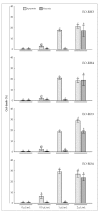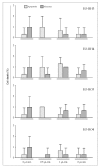Chemical Characteristics and Anticancer Activity of Essential Oil from Arnica Montana L. Rhizomes and Roots
- PMID: 32178275
- PMCID: PMC7143959
- DOI: 10.3390/molecules25061284
Chemical Characteristics and Anticancer Activity of Essential Oil from Arnica Montana L. Rhizomes and Roots
Abstract
Arnica montana L. is a medicinal plant with diverse biological activities commonly used in pharmacy and cosmetics. The attributes of A. montana are mainly related to the concentration and chemical composition of essential oils (EOs). Therefore, the objective of this study was to characterize the chemical composition of EOs derived from A. montana rhizomes and roots taking into account the age of the plants and to investigate the effect of the analyzed EOs on induction of apoptosis, necrosis, and autophagy in human glioblastoma multiforme T98G and anaplastic astrocytoma MOGGCCM cell lines. Rhizomes and roots of mountain arnica were harvested at the end of the third and fourth vegetation periods. The chemical composition of essential oils was determined with the GC-MS technique. Among the 37 components of the essential oil of A. montana, 2,5-dimethoxy-p-cymene (46.47%-60.31%), 2,6-diisopropylanisole (14.48%-23.10%), thymol methyl ether (5.31%-17.79%), p-methoxyheptanophenone (5.07%-9.65%), and α-isocomene (0.68%-2.87%), were detected in the rhizomes and roots of the three-year-old plants and in the rhizomes and roots of the four-year-old plants. The plant part (rhizome, root) and plant age can be determinants of the essential oil composition and, consequently, their biological activity. The induction of apoptosis (but not autophagy nor necrosis) at a level of 28.5%-32.3% is a promising result, for which 2,5-dimethoxy-p-cymene, 2,6-diisopropylanisole, thymol methyl ether, and p-methoxyheptanophenone are probably mainly responsible. The present study is the first report on the anticancer activities of essential oils from A. montana rhizomes and roots.
Keywords: Arnica montana L.; T98G and MOGGCCM cell lines; anticancer activity; essential oil; rhizomes; roots.
Conflict of interest statement
The authors declare no conflict of interest.
Figures






Similar articles
-
Essential Oil from Arnica Montana L. Achenes: Chemical Characteristics and Anticancer Activity.Molecules. 2019 Nov 16;24(22):4158. doi: 10.3390/molecules24224158. Molecules. 2019. PMID: 31744121 Free PMC article.
-
Chemical Composition of Essential Oil from Flower Heads of Arnica Chamissonis Less. under a Nitrogen Impact.Molecules. 2019 Dec 5;24(24):4454. doi: 10.3390/molecules24244454. Molecules. 2019. PMID: 31817349 Free PMC article.
-
Oil Secretory System in Vegetative Organs of Three Arnica Taxa: Essential Oil Synthesis, Distribution and Accumulation.Plant Cell Physiol. 2016 May;57(5):1020-37. doi: 10.1093/pcp/pcw040. Epub 2016 Mar 2. Plant Cell Physiol. 2016. PMID: 26936790
-
Final report on the safety assessment of Arnica montana extract and Arnica montana.Int J Toxicol. 2001;20 Suppl 2:1-11. doi: 10.1080/10915810160233712. Int J Toxicol. 2001. PMID: 11558636 Review.
-
Arnica montana L. - a plant of healing: review.J Pharm Pharmacol. 2017 Aug;69(8):925-945. doi: 10.1111/jphp.12724. Epub 2017 Apr 11. J Pharm Pharmacol. 2017. PMID: 28401567 Review.
Cited by
-
Identification of Withania somnifera-Silybum marianum-Trigonella foenum-graecum Formulation as a Nutritional Supplement to Contrast Muscle Atrophy and Sarcopenia.Nutrients. 2020 Dec 26;13(1):49. doi: 10.3390/nu13010049. Nutrients. 2020. PMID: 33375229 Free PMC article.
-
Effects of Arnica Phytotherapeutic and Homeopathic Formulations on Traumatic Injuries and Inflammatory Conditions: A Systematic Review.Plants (Basel). 2024 Nov 4;13(21):3112. doi: 10.3390/plants13213112. Plants (Basel). 2024. PMID: 39520030 Free PMC article. Review.
-
Antioxidant, Anti-Inflammatory, and Anticancer Activities of Five Citrus Peel Essential Oils.Antioxidants (Basel). 2024 Dec 19;13(12):1562. doi: 10.3390/antiox13121562. Antioxidants (Basel). 2024. PMID: 39765890 Free PMC article.
-
Chemical Characteristics and Antioxidant Activity of Arctostaphylos uva-ursi L. Spreng. at the Southern Border of the Geographical Range of the Species in Europe.Molecules. 2021 Dec 20;26(24):7692. doi: 10.3390/molecules26247692. Molecules. 2021. PMID: 34946773 Free PMC article.
-
Nitrogen Fertilization and Solvents as Factors Modifying the Antioxidant and Anticancer Potential of Arnica montana L. Flower Head Extracts.Plants (Basel). 2022 Dec 27;12(1):142. doi: 10.3390/plants12010142. Plants (Basel). 2022. PMID: 36616270 Free PMC article.
References
-
- Cavalieri E., Mariotto S., Fabrizi C., de Prati A.C., Gottardo R., Leone S., Berra L.V., Lauro G.M., Ciampa A.R., Suzuki H. α-Bisabolol, a nontoxic natural compound, strongly induces apoptosis in glioma cells. Biochem. Biophys. Res. Commun. 2004;315:589–594. doi: 10.1016/j.bbrc.2004.01.088. - DOI - PubMed
-
- Sharifi-Rad M., Varoni E.M., Salehi B., Sharifi-Rad J., Matthews K.R., Ayatollahi S.A., Kobarfard F., Ibrahim S.A., Mnayer D., Zakaria Z.A. Plants of the genus Zingiber as a source of bioactive phytochemicals: From tradition to pharmacy. Molecules. 2017;22:2145. doi: 10.3390/molecules22122145. - DOI - PMC - PubMed
MeSH terms
Substances
LinkOut - more resources
Full Text Sources
Miscellaneous

